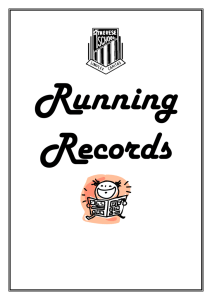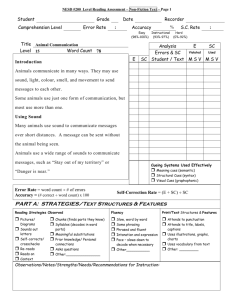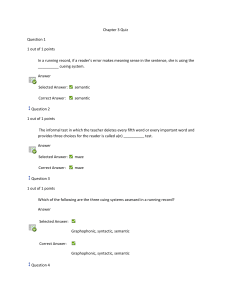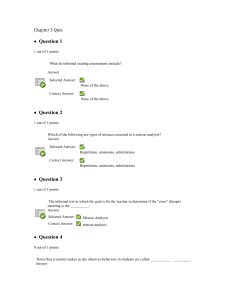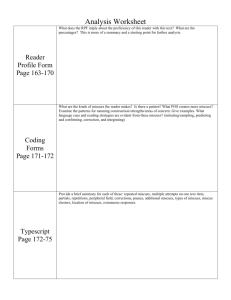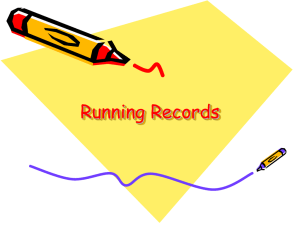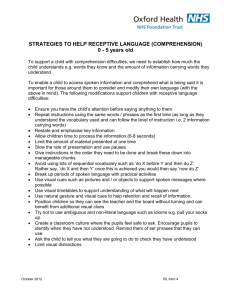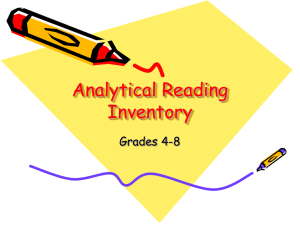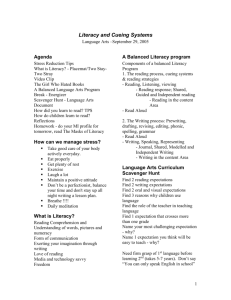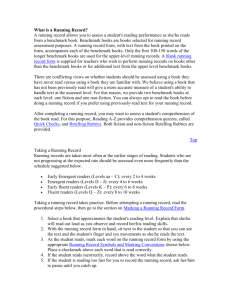running records - stantonteachers
advertisement
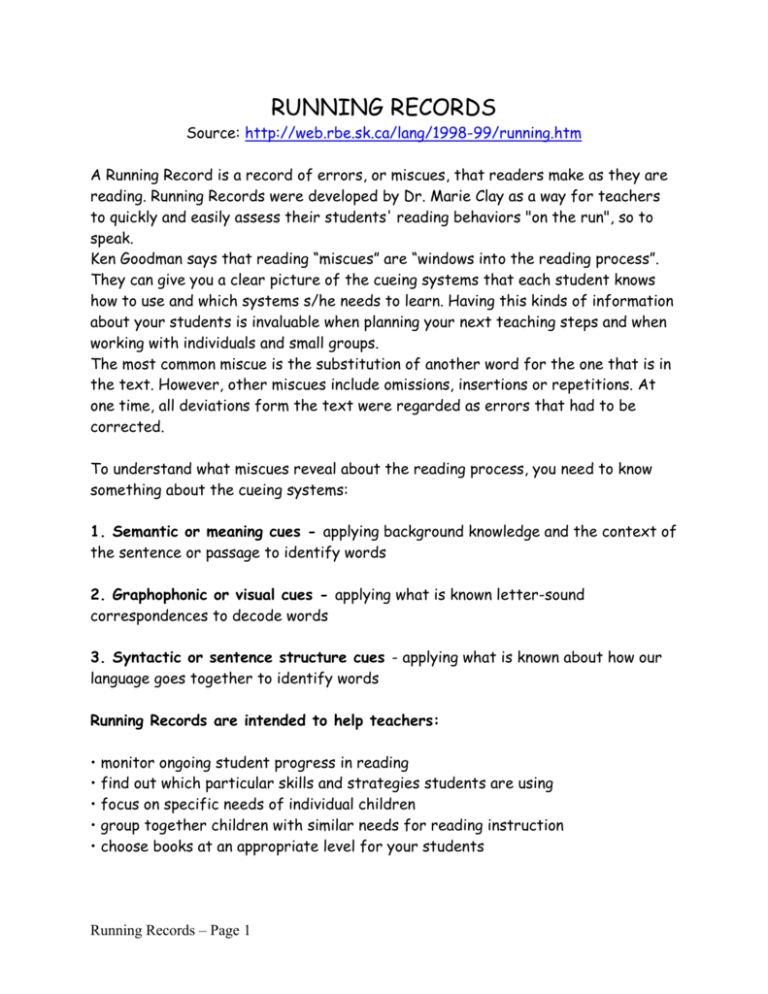
RUNNING RECORDS Source: http://web.rbe.sk.ca/lang/1998-99/running.htm A Running Record is a record of errors, or miscues, that readers make as they are reading. Running Records were developed by Dr. Marie Clay as a way for teachers to quickly and easily assess their students' reading behaviors "on the run", so to speak. Ken Goodman says that reading “miscues” are “windows into the reading process”. They can give you a clear picture of the cueing systems that each student knows how to use and which systems s/he needs to learn. Having this kinds of information about your students is invaluable when planning your next teaching steps and when working with individuals and small groups. The most common miscue is the substitution of another word for the one that is in the text. However, other miscues include omissions, insertions or repetitions. At one time, all deviations form the text were regarded as errors that had to be corrected. To understand what miscues reveal about the reading process, you need to know something about the cueing systems: 1. Semantic or meaning cues - applying background knowledge and the context of the sentence or passage to identify words 2. Graphophonic or visual cues - applying what is known letter-sound correspondences to decode words 3. Syntactic or sentence structure cues - applying what is known about how our language goes together to identify words Running Records are intended to help teachers: • • • • • monitor ongoing student progress in reading find out which particular skills and strategies students are using focus on specific needs of individual children group together children with similar needs for reading instruction choose books at an appropriate level for your students Running Records – Page 1 Taking the Record 1. Sit the child beside you and explain that you want her to read the book independently. 2. Read the title of the book to the child. 3. Give the child the book and use a record form or a blank sheet of paper to mark her reading behavior and record miscues. (A chart with 100 squares might be used to record one word per square to make word counts easier.) 4. When a child stops during reading, it is important that you allow enough time for her to work on a problem before you supply the word. It is also important that you do not wait so long that she loses the meaning of the story while trying to solve the unknown word. 5. Use a standardized system to record words read correctly, substitutions, omissions, deletions, and deletions. 6. Also take note of self-corrections. When a student corrects a miscue herself, it is an indication that she is monitoring her own comprehension. 7. You may also wish to note hesitations, repetitions and other reading behaviors that may not affect accuracy but provide information about the strategies the reader is using. Scoring the Record •Substitutions, insertions, omissions, teacher-told responses score as errors. •Repetitions are not scored as errors •Corrected responses are scored as self-corrections. There is no penalty for attempts that result in a correct response. •Multiple unsuccessful attempts at a word score as one error only. •If a child omits a line or lines, each word omitted is counted as an error. •If the child omits a page, deduct the number of words on the page from the total word count. Running Records – Page 2 •If the child repeatedly makes an error with a proper noun, count this as an error the first time only. All other incorrect responses count as errors each time. •Pronunciation differences are not counted as reading errors unless accompanied by incorrect locating responses. Calculating Accuracy Divide the number of words read correctly by the total number of words and multiply by 100 to find percentage of accuracy. Checking on Cues 1. For each miscue, try to determine whether the child is using cues from the meaning (semantics), the structure of the language (syntax), the visual information contained in the print (graphophonics) or a combination of these. 2. For self-corrections, you may also want to analyze what led the child to make this error and what cueing system she has used to correct it. 4. Tally the cues used to find out which cue or cues the child is using predominantly. The aim is for the child to use all cue sources together in order to decode accurately. Checking on Comprehension You may choose to do a comprehension check as part of the miscue analysis. 1. If you are using the check for your own teaching purposes, you might want to simply have the students retell the story in their own words. A retelling gives an indication of what the child knows about story structure, sequencing and the relative importance of information, as well as details from the story. 2. For a quicker and more objective check for reporting purposes, or are working with children who are unfamiliar with retelling, use comprehension questions. This will give you insights into which part of the comprehension process the child finds difficult. It is a good idea to ask a combination of literal and inferential comprehension questions. Running Records – Page 3 Assigning a Reading Level Use the accuracy data to ascertain the level - easy, instructional or difficult - of the selected text: Independent Reading Level - over 95% accuracy Instructional Reading Level - 90-95% accuracy Frustration level - below 90% accuracy Resources: Marie M. Clay, The Early Detection of Reading Difficulties. (Heinemann 1991) Irene C. Fountas and Gay Su Pinnell Guided Reading: Good First Teaching for All Students (Heinemann 1996) FOUNDATIONS Records of Reading Behavior from The Wright Group This website was created by Lori Rog, Language Arts Consultant, Regina Public Schools, 1600 - 4th Avenue, Regina SK Canada Running Records – Page 4 (Passage from Running Record Passage from Running Words: Flesch-Kincaid Reading Level: ) Name: _________________________ Date: _________ DOB: ______ Age: ____yrs ____mths School: ___________________________________ Recorder: ___________________________ Title/Text: _________________________ Emergent Early Fluent Seen Unseen Running Words (RW) _____ Errors (E) _______ Error Rate (ER) __1:______ ER = RW E Self-Corrections (SC) ______ Self-Correction Rate (SCR) _1:______ % Accuracy (ACC) ______ SCR = E + SC E | Cueing Systems Key: (Circle all cueing systems used under Error and Self-Correction Analysis) M= Meaning (Semantic) S = Structure (Syntactic) V = Visual (Graphophonic) Error Analysis Line # Text # Cueing System SC Analysis # Cueing System 1 M S V M S V 2 M S V M S V 3 M S V M S V 4 M S V M S V 5 M S V M S V 6 M S V M S V Running Records – Page 5 7 M S V M S V 8 M S V M S V 9 M S V M S V 10 M S V M S V 11 M S V M S V 12 M S V M S V 13 M S V M S V 14 M S V M S V 15 M S V M S V 16 M S V M S V 17 M S V M S V 18 M S V M S V 19 M S V M S V 20 M S V M S V Running Records – Page 6 Running Record Calculation and Conversion Table Whether children are reading seen or unseen texts, most of their reading will contain errors. This is fortunate because it allows teachers to observe how children work on texts to problem -solve and monitor their own reading. The Conversion Table provides for a quick conversion of error rate to a percentage accuracy score. This allows teachers to offer children texts which provide the support of a meaningful context within which to do their problem-solving CONVERSION TABLE Error rate Percent (Errors : # of Words) accuracy Independent Level 1 : 200 99.5 1 : 100 99 1 : 50 98 1 : 35 97 1 : 25 96 1 : 20 95 Instructional Level 1 : 17 94 1 : 14 93 1 : 12.5 92 1 : 11.75 91 1 : 10 90 Frustration Level 1:9 89 1:8 87.5 1:7 85.5 1:6 83 1:5 80 1:4 75 1:3 66 1:2 50 Running Records – Page 7 Good opportunities for teachers to observe children's 'reading work'. The reader tends to lose the support of the meaning of the text. RUNNING RECORD CALCULATIONS (RW = Running words; E = Errors; SC = Self -corrections) Error Rate Running words Errors e.g., 150 = Ratio 10:1 15 Accuracy 100 - E X 100 RW 1 e.g. 100 - 15 X 100 = 150 1 90% accuracy Running Records – Page 8 Self-Correction Rate E + SC SC e.g., 15 + 5 = 5 Ratio 1 : 4
